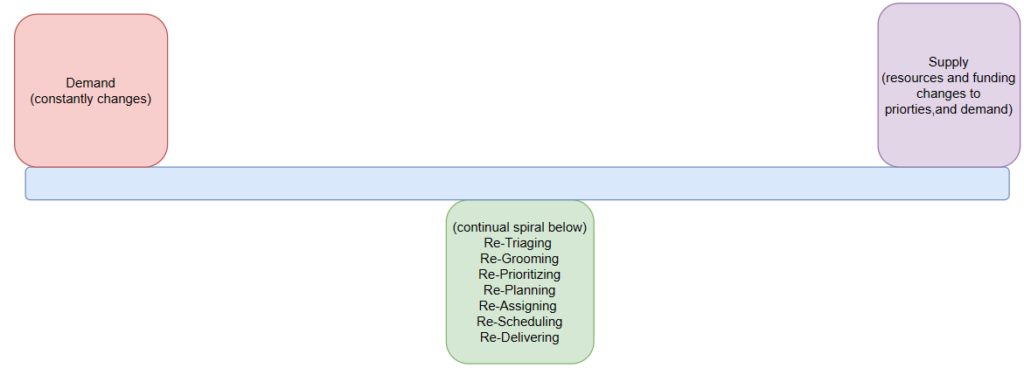Business Enterprise Architecture Model: Balancing Demand and Supply

Objective: This model addresses the core challenge faced by business enterprise architecture organizations: striking a balance between demand and supply. Given that both elements are in constant flux, it becomes imperative for businesses to realign their strategies accordingly.
Components:
- Demand: It represents the needs and wants of your stakeholders. This could be your customers, management, or even citizens in some cases. The demand side is inherently dynamic, and keeping up with its changes is crucial for business success.
- Supply: This component encompasses what the organization can provide in terms of funding, resources, and prioritization. Understanding your supply side means having a grip on available assets and how they can be best allocated.
The Realignment Process:
As the landscape of demand and supply shifts, businesses must undergo a series of adjustments. Here are the stages involved:
- Triaging: At this stage, businesses identify what’s most essential. It’s about understanding what demands are most pressing and need immediate attention.
- Re-grooming: This is an analytical phase where you reassess and determine what needs to be done based on current conditions.
- Reprioritizing: Given the shifting sands of demand and supply, re-establishing priorities becomes crucial. What was essential a month ago might not hold the same significance today.
- Replanning: With new priorities in place, it’s time to strategize how you’ll address them.
- Reassigning: Determining who in the organization will handle what tasks. It’s about distributing responsibilities effectively.
- Rescheduling: This pertains to time management. When will a particular demand be addressed? When will the results be visible?
- Redelivering: This is the execution phase where strategies are put into action, and deliverables are rolled out.
Relation to Cybernetics:
The model draws parallels with cybernetic principles, which stress the importance of feedback loops and adaptive systems. Just as in cybernetics, this model emphasizes the need to constantly monitor, assess, and adjust based on feedback. It’s a cycle of understanding, adapting, and evolving, much like the trajectory discussions centered around “the holiday of Ricky” (though more context is needed to fully understand this reference).
In conclusion, this model serves as a compass for business enterprise architecture organizations, guiding them through the unpredictable waters of demand and supply. It is a blueprint for staying relevant and effective in a continually changing business environment.